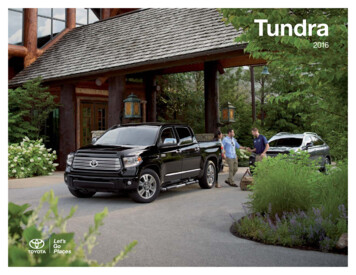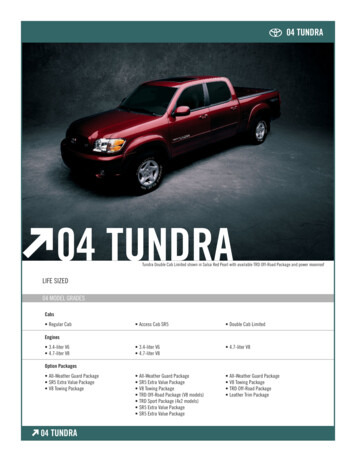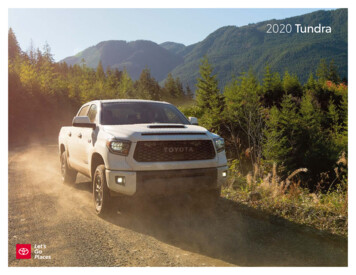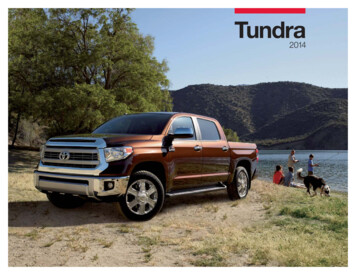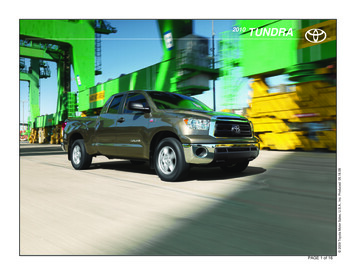
Transcription
Tundra BiomesTundra and AlpineTundra Biomes§ Arctic tundra occurs north of the boreal forest or taiga and thus form atreeless ring south of the zone of permanent ice (North America,Greenland, Eurasia).§ Tundras are characteristic of Arctic or Alpine regions where the severityof environmental conditions excludes tree growth. 30 days of 10 C ave.temperature and 8 mos cold season.Tundra Biomes§ In the Antarctica, tundra area is very small because of the lack of largecontinental masses. Develops only on certain small Antarctic islands suchas South George and MacQuarie Island on several spots on the mostnortherly extension of Antarctica proper (only 2 flowering plants!)Deschampsia antarcticaColobanthus quitensisOnly 2 angiosperms - Antarctichairgrass, pearlwort - on north facingslopes with moss and liverwortsAntarctic Peninsula - 600 mi or 1000 km fromSouth America
Tundra Biomes§ In the wet subAntarctic, tussocks and megaherbs are characteristicTundra Biomes§ Alpine regions include Rocky Mountains, European Alps, Himalayas,and Austral-antarctic area (South Island, also Tasmania, Snowy Mts. inAustralia).Alpine summit, Bighorn NatlForest, 9000ft, Wyomingwith Ranunculus adoneus(snow buttercup)Megaherb Pleurophyllum speciosumin subantartic Campbell IslandTussock Poa litorosa in subantarticCampbell IslandTundra Biomes§ Exclude tropical ‘puna’ in Andes and similar high elevation peaks inEast Africa (will deal with later). Links of Austral-antarctic region withpuna (Azorella, Umbelliferae).Alpine tundra, Summit Lake, SWIdaho Springs, CO - Rydbergiagrandiflora, Polygonumbistortoides (American bistort)Tundra Biomes§ Low precipitation; less than 400 mm peryear, usually only up to 150 mm — less rainthan most subtropical deserts!§ Subzero temperatures most of the year. Ashort vegetative period of generally less than50 days between spring and autumn frost.Peru - puna, 4300 ftAzorella (Apiaceae)
Tundra BiomesTundra Biomes§ Permanently frozen sub-soil. Permafrost of variable depth.§ Consequences are physical barrier to roots, low temperatures suppressdecomposition and promotes peat, and retard water percolation and promotesswampy or boggy conditions§ Life forms: chamaephytes (incl. subshrubs) and hemicryptophytes by farthe dominant forms, often cushionsTasmanian (Mt. Anne), montanecushions, largest in the world,Abrotanella, Asteraceae, 12 ftacross with 106 stemsMoss campion (Silene acaulis) and purplesaxifrage (Saxifraga oppositifolia) at SvalbardLocations of permafrost in tundraand high borealTundra BiomesTundra Biomes§ Life forms: grasses and sedges dominate (e.g., North America: Poa arctica,alpine meadow grass; Carex bigelowii, rigid sedge)§ Life forms: vegetative reproduction common (bulbils or vivipary; eg.Polygonum viviparum, alpine bistort)Carex bigelowii arctic sedgePolygonum viviparum - alpine bistortPoa arctica - alpine meadow grassPoa alpina var. vivipara
Tundra BiomesTundra Biomes§ Life forms: apomixis, wind and “generalized” fly/bee pollinated incidence of conspicuously-open bowl flowers increases towards the arctic§ Life forms: apomixis, wind and “generalized” fly/bee pollinated incidence of conspicuously-open bowl flowers increases towards the arcticCerastium - chickweedRanunculus - buttercupSt. Paul Island, Alaska tundraPapaver - poppySaxifraga - saxifrageTundra Biomes§ Life forms: PolyploidyFrequency of polyploids (black %) inthe floras of various territories in theNorthern Hemisphere (from Love andLove, 1974)Tundra Biomes§ Life forms: PolyploidySpitsbergen
Tundra BiomesTundra SubBiomes§ High arctic - herbsMean July temperature: 0-3 CSummer warmth index 6 C§ Middle arctic - dwarfshrubFog-shrouded islands neararctic icepackDominated by herbs - the“high arctic”§ Low arctic - shrubbyheath, small index.shtmlHerb subzonePapaver - poppyTundra SubBiomesTundra SubBiomesDominant plant growth forms:Cushion forbs, mosses, lichensNumber of vascular plantspecies in local flora 50Mean July temperature: 3-5 CSummer warmth index: 6-9 CTransitional to subzone C andtogether they have been calledthe “middle arctic”Herb subzoneProstrate shrub (or Dryas)subzoneDryas - mountain avens(Rosaceae) & pollen
Tundra SubBiomesTundra SubBiomesDominant plant growth form:Prostrate dwarf shrubsNumber of vascular plantspecies in local flora: 50-100Mean July temperature: 5-7 CSummer warmth index: 9-12 CSalix herbacea - least willowDryas octopetalaSalix polaris - polar willowCerastium regellii - chickweedProstrate shrub (or Dryas)subzonehemi-prostrate dwarf-shrub(or Cassiope) subzoneTundra SubBiomesTundra SubBiomesDominant plant growth forms:Hemi-prostrate dwarf shrubs,sedgesNumber of vascular plantspecies in local flora: 75-150Carex bigelowii arctic sedgeMean July temperature: 7-9 CSummer warmth index: 12-20 CDominant plant growth forms:Erect dwarf shrubs, sedges,mossesNumber of vascular plantspecies in local flora: 125-250Juncus trifidus - rushhemi-prostrate dwarf-shrub(or Cassiope) subzoneCassiope tetragona(Ericaceae) - Arctic bellheatherCassiope tetragona(Ericaceae) - Arctic bellheatherErect-shrub (or Betula nana)subzone
Tundra SubBiomesMean July temperature: 9-12 CSummer warmth index: 20-35 CDominant plant growth forms:Low shrubs, tussock sedges,mossesNumber of vascular plantspecies in local flora: 200-500Tundra Biomes§ Floristics: Circum-boreal distribution common, Amphi-atlantic, Amphipacific often the case as wellRhododendron lapponicum in WisconsinLow shrub (or Alnus) subzonein ScandanaviaTundra Biomes§ Floristics: Circum-boreal distribution common, Amphi-atlantic, Amphipacific often the case as well — sometimes as different varietiesVaccinium vitis-idaea var. minus(mountain cranberry in NorthAmerica)Vaccinium vitis-idaea var. vitisidaea (lingon in Eurasia)Tundra Biomes§ Faunistics: Circum-boreal distribution common as with caribou (NorthAmerica) and reindeer (Eurasia) — slightly different looking but same speciesRangifer tarandus (actually a number of subspecies)
Tundra BiomesAlpine Biomes§ Faunistics: other Circum-boreal distributions§ Floristics: Alpine vegetation does not form continuous expanses but arebest characterized as islandsAlpine meadow distribution European alpsArctic foxArctic hareEagles Nest Wilderness, ColoradoArctic squirrelMuskoxAlpine Biomes§ Floristics: Alpine vegetation shows very close resemblances both in lifeforms and in species composition to that of the Arctic tundra. A whole groupof species are common to both and referred to as 'Arctic-Alpine' species.Alpine Biomes§ Floristics: Important Alpine families - Gentianaceae (gentians),Primulaceae (primroses)Salix arctica - Alpine willowCerastium - chickweed, Colorado Rocky Mts.Primula farinosa & Gentiana verna, Austrian alps
Alpine Biomes§ Floristics: Important Alpine families - Ericaceae (blueberries), Rosaceae(avens)Alpine Biomes§ Floristics: Important Alpine families - Portulacaceae (spring beauty,bitterroot)Claytonia megarhiza - alpinespring beauty - western NorthAmericaRhododendrum hirsutum in AlpsDryas, Switzerland AlpsLewisia rediviva - bitterroot - MontanaTundra Biomes§ Origins§ forest grew at high latitudes across North America andEurasia until the late Pliocene (3mya)§ fossil remains of dawn redwood, swamp cypress,Ginkgo, and other broad-leaved genera are commonthroughout the Canadian Arctic and Eastern Siberia§ Alaska (most of it) switched over from coniferousforest to shrubby and herbaceous tundra during thePleistocene epoch (2mya)§ bipolar distributions occur because of high elevationzones in mountain rangse running through North andSouth America§ the alpine flora in southern Hemisphere appear to berelictual from an extensive tundra flora in Antarctica priorto being covered by iceTundra Biomes§ Future?environment360 report§ most impacted biome by warming temperatures§ 3-5o F in last 50 years; up to 10o F above preindustrial levels by 2100§ shift from “herbaceous” to shrub tundra (“tundra”means “treeless plain” in Finnish)§ increased incidence of fire, slumping hillsides§ 2X as much C exists in permafrost as in atmosphere . . .§ . . . and large amounts of methane – even more potentgreenhouse gas
temperature and 8 mos cold season.! Tundra Biomes!! Arctic tundra occurs north of the boreal forest or taiga and thus form a treeless ring south of the zone of permanent ice (North America, Greenland, Eurasia). ! Tundra Biomes!! In the Antarctica, tundra area is very small because of the lack of large continental masses.

